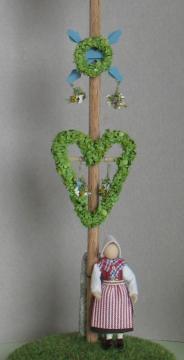The Swedish Midsummer poles are a part of the European Maypole tradition. Maypoles have different designs in different countries or regions, and their looks have changed over time - at least in Sweden.
Midsummer poles today

If you ask a Swedish kid to draw a Midsummer pole, it'll typically look like this sketch:
At Midsummer Eve, the newly dressed pole is raised and children and adults play dance games around it. Often a local folk dance team (all in folk costumes) will perform traditional dances to the tunes of a fiddler.
There's no Swedish equivalent of the Maypole ribbon dance seen in England.
Origins of the Midsummer pole
The Swedish Midsummer pole is part of the European Maypole tradition; it seems to have came to Sweden from Germany in late Medieval times, like the Christmas tree did some centuries later. Germany was long a major cultural influence on Sweden as it was our most important trade partner, and in the Medieval era there were many German merchants and craftsmen in Swedish towns. This far North, Spring and Summer arrive later than at the continent, so it was easier to gather birch leaves and flowers to decorate the pole by Midsummer than in early May - hence Sweden has Midsummer poles rather than Maypoles.

Reproduction: Kungliga Biblioteket (Royal Library, Sweden)
In Sweden, Midsummer poles or Maypoles first became popular with townspeople and the upper classes, and eventually spread to the farming community. The earliest pictures of them are found "Suecia Antiqua et Hodierna" (Latin for "Sweden past and present") - a circa 1700 work with engravings of several Swedish towns, palaces and manors. A number of the pics include one or more poles - like the pic to the right, and the towns Borås and Skara (images reproduced by the Royal Library). The artist "improved" on the houses and towns to make them look more impressive (the books were partly intended to promote Sweden among foreign dignitaries) - so possibly he may have made the Maypoles bigger and better as well? Note that the designs of the poles vary somewhat, and look rather different from today's typical Midsummer pole shown above. They're topped by flags, but up to the late 19th century the Swedish flag was only used by the military, so I suspect these flags are simply solid color cloths.
Midsummer day traditionally falls on St. John the Baptist's day (June 24), but in Sweden it's been set to the Saturday between June 20 and June 26 since 1953. Bonfires is the earliest documented Midsummer tradition in Sweden, mentioned in Olaus Magnus' 1555 work "The history of the Nordic people".
Some suggest the pole is a phallic symbol from pagan times in Scandinavia, but there's no evidence of that at all. Even if the Maypole tradition would be that old, it wasn't introduced in Sweden until well into the Christian era, so any underlying symbolism should be traced in Germany rather than here.
Maypole from Dalarna


In Dalarna (or Dalecarlia) province, old traditions were kept alive longer than in the rest of Sweden. Their Midsummer poles are tall and slender, reminiscent of the designs in the old pics above. Each village has its own design, somewhat different from its neighbors. The pole itself is usually painted white like a flagpole, but occasionally you see unpainted poles that have weathered to a silver grey. The poles are permanent features in the villages; for Midsummer each year, they're lowered, refurbished and raised again.
My Midsummer pole is based on one I've seen in Leksand parish in Dalarna. I made both a Summer and a Winter version, and as I plan to use the Winter version in a setting, I left the pole unpainted so it'll show against the snow. The Winter version has withered greenery made from smoking pipecleaners dyed with wood stain. (I simplified that one a bit, leaving out the rooster found on the Summer version, as well as the hanging flower bouquets.) The crossed arrows are a standard feature of Midsummer poles in Dalarna, and allude to the province's coat of arms, which shows two crossed arrows.
I included a doll in the Summer photo for scale. She wears a folk costume from Leksand parish (I'll write more about it in some later update).
